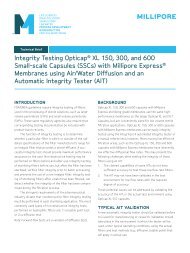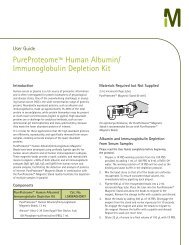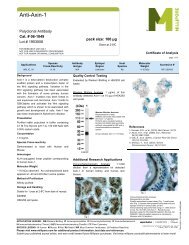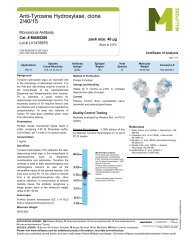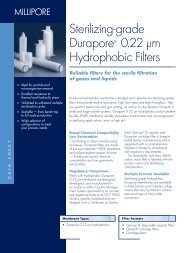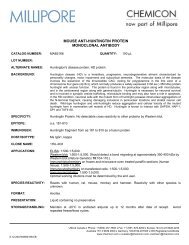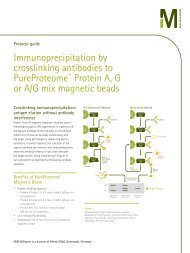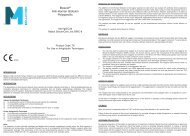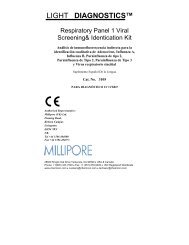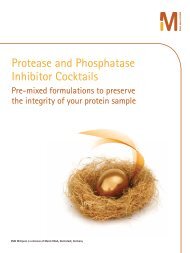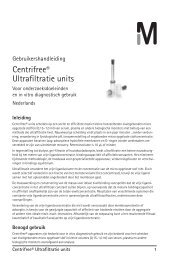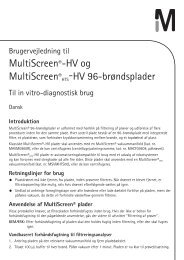Full Text Article - Millipore
Full Text Article - Millipore
Full Text Article - Millipore
You also want an ePaper? Increase the reach of your titles
YUMPU automatically turns print PDFs into web optimized ePapers that Google loves.
Experimental<br />
Water Purification System<br />
A combination of technologies is necessary to produce<br />
ultrapure water. Methods for tracing classes of<br />
organic matter at different points in a water<br />
purification system were first described in 1987 8 .<br />
Combination techniques were also used to obtain<br />
meaningful information about contamination in the DI<br />
water process 9 . The configuration used during this<br />
qualitative study is made up of two new water<br />
purification systems. The first one combines reverse<br />
Chromatographic conditions<br />
Equipment<br />
RO reject<br />
RO permeate<br />
EDI Product Reservoir<br />
The following equipment was used throughout the<br />
experiment:<br />
HPLC pumps delivering a gradient eluent at<br />
2.0 ml/min<br />
Computer for data acquisition and system control<br />
Injector for 100 µL injection with 250 µL loop, 200 µL<br />
syringe, and appropriate vials.<br />
Detectors: Dual detectors operated at 214 nm and<br />
254 nm (Waters Corp, Milford, Mass, USA).<br />
Column Type: Waters µBondapak ® C-18 column,<br />
3.9 x 300 mm (#27324).<br />
Precolumn Type (optional): C18 (Waters µBondapak<br />
C-18 Guard-Pak TM (#T33552))<br />
Elution solvents:<br />
Water (fresh Milli-Q ® system water (<strong>Millipore</strong>))<br />
Acetonitrile (HPLC grade: J.T. Baker JT9017 or<br />
equivalent).<br />
The bottles were rinsed in 10% nitric acid, washed<br />
extensively with fresh Milli-Q system water before<br />
sampling.<br />
Figure 5: The water purification chain studied.<br />
osmosis and electrodeionization techniques. This<br />
purified water is stored in a 60 l reservoir. This high<br />
purity water tank is specifically designed for the<br />
optimization of high purity water storage 10 . A second<br />
system combining activated carbon, ion exchange<br />
resins and UV treatment is fed by this pretreated<br />
water.<br />
Sampling ports are ensured throughout the process<br />
(see arrows in Figure 5)<br />
HPLC gradient<br />
Ultrapure<br />
water<br />
The following elution gradient was used throughout<br />
the experiment. 50 ml of each water sample were<br />
injected (except for tap water and RO reject water<br />
where 1 ml was used) in order to concentrate trace<br />
impurities on the column.<br />
Time [minutes] Flow [ml/min.] Water % Acetonitrile %<br />
0.0 2.0 100 0<br />
2.0 2.0 100 0<br />
12.0 2.0 0 100<br />
15.0 2.0 0 100<br />
19.0 2.0 100 0<br />
25.0 2.0 100 0<br />
The acquisition time was fixed at 14 minutes with a<br />
4 point/second acquisition rate and a resolution<br />
over 20 bit.<br />
Chromatograms were compared at different<br />
maintenance conditions and during the different<br />
water purification stages.<br />
The R&D Notebook: From tap to ultrapure water: tracking organic contaminants 3



